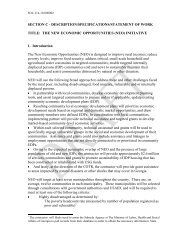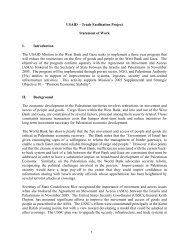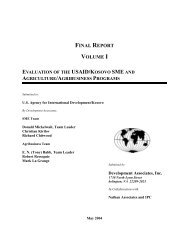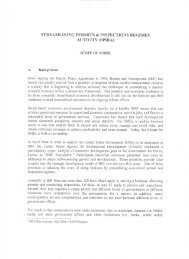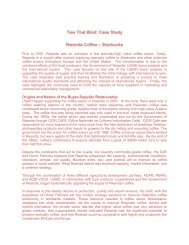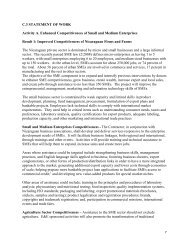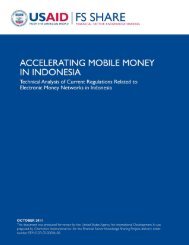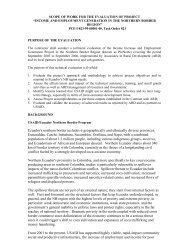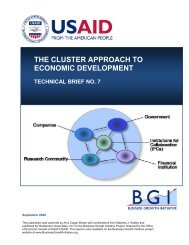BGI Final Report - Economic Growth - usaid
BGI Final Report - Economic Growth - usaid
BGI Final Report - Economic Growth - usaid
Create successful ePaper yourself
Turn your PDF publications into a flip-book with our unique Google optimized e-Paper software.
Firm-Level Technology Diffusion1. Adoption of technology (Firm-Level Technology Absorption, GCR 9.02). This measures thedegree to which companies in a country are able to absorb new technology. Scale of 1-7,where 7 suggests that companies are very able to adopt new technology, while 1 indicatesthat they are virtually incapable of doing so.Concluding Thoughts: Using the Indicators to Identify Points of EntryThis tool is designed to be diagnostic in nature. As such, its purpose is to paint a picture of theenvironment which influences enterprise success, while refraining from attempting to highlightspecific programmatic responses. For this reason, most of the indicators selected are outputorientedrather than causal in nature.The programmatic interventions likely to be developed in response to the diagnostic could benumerous, varied and possibly a function of competing demands. The observations drawn fromthe diagnostic may not be the only factors bearing on the kinds of interventions that can bepursued. However, the diagnostic can generically be used as a starting point in two ways.Each of the thematic areas can be viewed:1) As potential obstacles to enterprise development or,2) As potential sources of competitive advantage.If one takes the first view, a possible approach is to remove the obstacles that present thegreatest challenge to enterprises. Viewed as such, one would look at the areas of greatestweakness and to prioritize those for more careful consideration. For example, if a determinationwas made that the single biggest barrier to enterprise success was the regulatory environment,a project focusing on that area may be the most appropriate.If one takes the second view, perhaps the best approach is to choose the thematic area inwhich the country is strongest, and to try to enhance that area until it becomes a source ofcompetitive advantage for its firms. For example, a country that is weak in the other areas buthappens to have a strong culture of technology creation and diffusion may be best off takingadvantage of that strength by trying to encourage its firms to become world-class in that area.In either case, it is very important to benchmark other comparator and best-practice countries toprovide context. The diagnostic cannot be conducted in a vacuum; the quality of a country’sbusiness environment must be viewed in relationship to other countries’. Additionally, thediagnostic is a static tool that is only a snapshot of a constantly changing environment, and theexercise must be repeated regularly to maintain an updated picture. As the environmentchanges, so too may program interventions; this highlights the need for flexibility inprogramming and a willingness to change approaches if that becomes necessary to takeadvantage of new opportunities.All tools that use indicators as their basis are imperfect, because they rely on the (imperfect)quality of the underlying indicators. However, this tool can paint a fair picture of the enterpriseoperatingenvironment, and, more importantly, can provide insight into the ways that enterprisesare reacting to that environment.42




